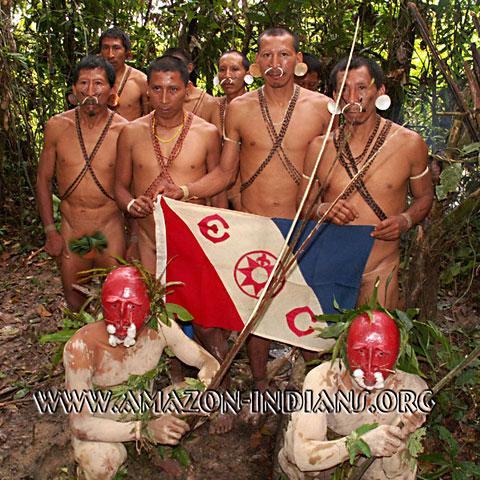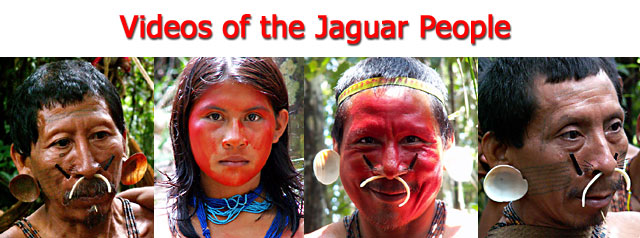he Explorers
Club in cooperation with Amazon-Indians.org provided medical care to
indigenous people in Peru, Brazil, and Colombia during the first two weeks of
April, 2005. The flag expedition visited Matis, Ticuna, Mayoruna, Marubo, and Yagua communities in the Tres Fronteras (Three Frontiers) area.
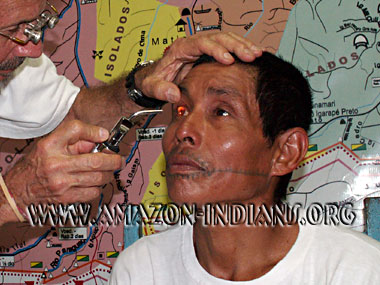 The
editor of Amazon-Indians, Dr. Dan James Pantone,
served as the expedition leader and made local contacts with various indigenous
communities near the Amazon River in Colombia and the Yavarí River in Brazil and
Peru. The medical team consisted of an ophthalmologist and an ophthalmic
technician who made eye-examinations and
fitted eyeglasses. The objectives of the expedition were to document the culture of the Matis Indians and
other indigenous tribes in the area and to provide
eye care to the people. The
editor of Amazon-Indians, Dr. Dan James Pantone,
served as the expedition leader and made local contacts with various indigenous
communities near the Amazon River in Colombia and the Yavarí River in Brazil and
Peru. The medical team consisted of an ophthalmologist and an ophthalmic
technician who made eye-examinations and
fitted eyeglasses. The objectives of the expedition were to document the culture of the Matis Indians and
other indigenous tribes in the area and to provide
eye care to the people.
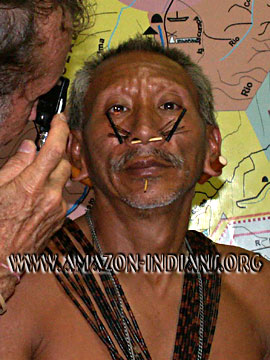 The Explorers Club is a prestigious organization with Sir Edmund Hillary, the
first person to scale Mount Everest, as its honorary chairman. This was a flag
expedition and the historic flag used in this expedition (Flag Number 99) was also used in the
American Expedition to Antarctica in the 1930s. The Explorers Club is a prestigious organization with Sir Edmund Hillary, the
first person to scale Mount Everest, as its honorary chairman. This was a flag
expedition and the historic flag used in this expedition (Flag Number 99) was also used in the
American Expedition to Antarctica in the 1930s.
Equipped with eye examination equipment and over 200 pairs of glasses the
expedition began on the River Yavarí in Brazil and Peru where members of the
Matis, Marubo, and Mayoruna Tribes were examined and fitted for eyewear. Later
the expedition visited Ticuna and Yagua communities in Colombia near the Amazon
River. The fact that the eyeglasses were dispensed to the natives at no charge
made for great relations, especially with natives who were familiar with western
medicine and eyeglasses. Although eyeglasses were foreign to some elder
individuals,
they accepted wearing glasses after they realized they will only have to wear
them for near vision tasks such as craftwork, stringing beads, and making
hunting equipment.
 Some of the indigenous tribes paid complements to the expedition members by
demonstrating various medicinal remedies and various ceremonies. This was
particularly true of the Matis Indians who demonstrated a plant extract that
they use to improve their vision, which is critical for a hunter-gather tribe.
Moreover, they demonstrated three ceremonies - the Ceremony of Mariwin, the
Ritual of Capybara, and the Dance of Queixada. Mariwin is very colorful as the
participants paint their bodies black, wearing only green ferns and red masks.
They carry sticks which they use to strike children, thereby transferring
"energy." While less colorful than Mariwin, the Ritual of Capybara is more
musical. During this ceremony, the participants are also naked, but do not paint
their bodies. Instead they apply wet clay to their bodies and make sounds like
capybaras (Hydrochoeris hydrochaeris), the world’s largest rodent,
creating an atmosphere that is not only visually stimulating but auditory as
well. During the Dance of Queixada, the participants paint themselves red with
urucum (annatto) and dance in a line while imitating sounds of the
Queixada (Tayassu pecari, a wild pig that is native to the
Amazon). Some of the indigenous tribes paid complements to the expedition members by
demonstrating various medicinal remedies and various ceremonies. This was
particularly true of the Matis Indians who demonstrated a plant extract that
they use to improve their vision, which is critical for a hunter-gather tribe.
Moreover, they demonstrated three ceremonies - the Ceremony of Mariwin, the
Ritual of Capybara, and the Dance of Queixada. Mariwin is very colorful as the
participants paint their bodies black, wearing only green ferns and red masks.
They carry sticks which they use to strike children, thereby transferring
"energy." While less colorful than Mariwin, the Ritual of Capybara is more
musical. During this ceremony, the participants are also naked, but do not paint
their bodies. Instead they apply wet clay to their bodies and make sounds like
capybaras (Hydrochoeris hydrochaeris), the world’s largest rodent,
creating an atmosphere that is not only visually stimulating but auditory as
well. During the Dance of Queixada, the participants paint themselves red with
urucum (annatto) and dance in a line while imitating sounds of the
Queixada (Tayassu pecari, a wild pig that is native to the
Amazon).
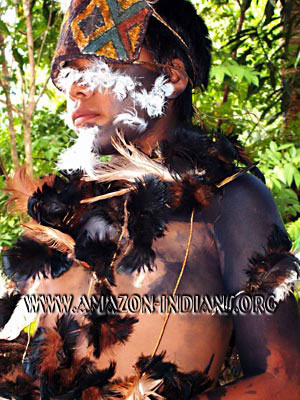 The Ticuna Indians after being examined and fitted for eyeglasses graciously
demonstrated the Ceremony of Pelazon, a rite of passage for Ticuna girls. One
feature that characterizes the ceremony is the use of the black dye obtained
from fruit of the huito tree (Genipa americana). The entire body
of the girl was painted black with huito and the symbol of her clan, the
guacamayo (macaw), was painted on her face, and interestingly girls are
not permitted to intermarry within their own clan. All her hair was removed.
Formerly, they would actually pull out the hair out by hand, but currently the
process is often less painful and scissors are commonly used. During the
ceremony, the Ticuna girl was dressed with feathers and wore a crown. In
addition, downy feathers were initially used to cover her eyes preventing her from seeing. Snail shells (which
represent fertility) were hung from her belt as this ceremony is not only a rite
of passage but a ceremony of fertility. Purification by fire is also part of the
ceremony. The purification consisted of having the girl continuously jump over a
fire. Some participants wear huge masks which represent mythological beings and
danger. The girl dances with the masked beings which symbolizes her
metamorphosis into adulthood and her ability to successfully deal with the
dangers of being an adult. The Ticuna Indians after being examined and fitted for eyeglasses graciously
demonstrated the Ceremony of Pelazon, a rite of passage for Ticuna girls. One
feature that characterizes the ceremony is the use of the black dye obtained
from fruit of the huito tree (Genipa americana). The entire body
of the girl was painted black with huito and the symbol of her clan, the
guacamayo (macaw), was painted on her face, and interestingly girls are
not permitted to intermarry within their own clan. All her hair was removed.
Formerly, they would actually pull out the hair out by hand, but currently the
process is often less painful and scissors are commonly used. During the
ceremony, the Ticuna girl was dressed with feathers and wore a crown. In
addition, downy feathers were initially used to cover her eyes preventing her from seeing. Snail shells (which
represent fertility) were hung from her belt as this ceremony is not only a rite
of passage but a ceremony of fertility. Purification by fire is also part of the
ceremony. The purification consisted of having the girl continuously jump over a
fire. Some participants wear huge masks which represent mythological beings and
danger. The girl dances with the masked beings which symbolizes her
metamorphosis into adulthood and her ability to successfully deal with the
dangers of being an adult.
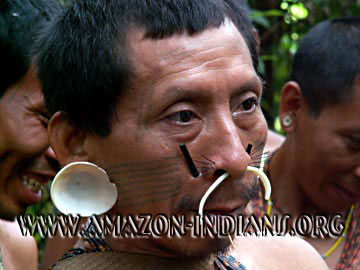 At one point the expedition participants found themselves stranded, paddling
down the Amazon River after the boat motor seized and was unrepairable. Although
the conditions were difficult with the frequent torrential rains and despite
boat motor problems, the expedition was a success in that they were able to
successfully dispense glasses to all the indigenous peoples that requested eye
care. At one point the expedition participants found themselves stranded, paddling
down the Amazon River after the boat motor seized and was unrepairable. Although
the conditions were difficult with the frequent torrential rains and despite
boat motor problems, the expedition was a success in that they were able to
successfully dispense glasses to all the indigenous peoples that requested eye
care.
For more information and to see more photos of the expedition, please visit the
Explorers Club Photo Gallery located at
http://www.amazon-indians.org/explorers/index.htm.
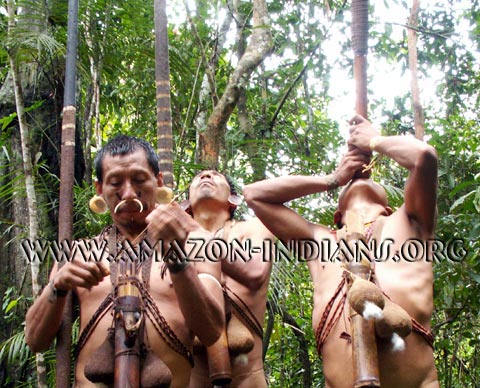 Extraordinary
videos of this and other expedi- tions to the Matis Indians are
available. If you would like to learn how you can meet the
Matis, Mayoruna-Mat-sés, and Ticuna Indians and find out how you can help them
preserve their cultures, please contact
djpantone@amazon- indians.org. Extraordinary
videos of this and other expedi- tions to the Matis Indians are
available. If you would like to learn how you can meet the
Matis, Mayoruna-Mat-sés, and Ticuna Indians and find out how you can help them
preserve their cultures, please contact
djpantone@amazon- indians.org.
The author, Dr. Dan James Pantone, is the editor
of Amazon- Indians and the founder of
the Movement in the Amazon for Tribal
Subsistence and Eco- nomic Sustainability (MATSES),
a nonprofit association that is
helping native Amazonians
so that they themselves can preserve their culture
and lands in a sustainable and independent way.
|


